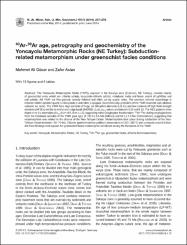40Ar-39Ar age, petrography and geochemistry of the Yoncayolu Metamorphic Rocks (NE Turkey): Subduction-related metamorphism under greenschist facies conditions. N. Jb. Miner. Abh. (J. Min. Geochem.), 191, 3, 257-276(20), DOI: 10.1127/0077-7757/2014/0260.

Göster/
Erişim
info:eu-repo/semantics/openAccessTarih
2014-06Erişim
info:eu-repo/semantics/openAccessÜst veri
Tüm öğe kaydını gösterÖzet
Abstract: The Yoncayolu Metamorphic Rocks (YMR), exposed in the Sakarya zone (Erzincan, NE Turkey), consists mainly of greenschist rocks which are chlorite schists, muscovite-chlorite schists, metabasic rocks and lesser extent of pyhllites and calc-schists. All YMR are fine-grained, weakly foliated and often cut by quartz veins. The common mineral assemblage is chlorite+albite+epidote+quartz ± clinozoisite ± actinolite ± opaques. Geochemically, protoliths of the YMR resemble calc-alkaline volcanic arc rocks. The YMR have high contents of large ion lithophile elements (LILEs) and low contents of high field strength elements (HFSEs) similar to mid-ocean ridge basalt (MORB). (La/Lu)CN values are between 0.26 and 6.16. The REE patterns show slight or no Eu anomalies (EuCN/Eu* of 0.48 to 1.13), suggesting minor plagioglase fractionation. 40Ar-39Ar dating on plagioclases from the metabasic samples of the YMR gave ages of 100.8 ± 3.4 Ma (Albian) and 94.1 ± 3.3 Ma (Cenomanian), suggesting that metamorphism was related to the closure of the Neo-Tethyan Ocean. Metamorphism took place during subduction of the Neo- Tethyan Ocean between ~ 90 –70 Ma. Chlorite geothermometry yielded a temperature of 320 – 350 °C and a pressure around 4 kbar. All these findings lend support for greenschist facies metamorphic conditions during the formation of the YMR.

















